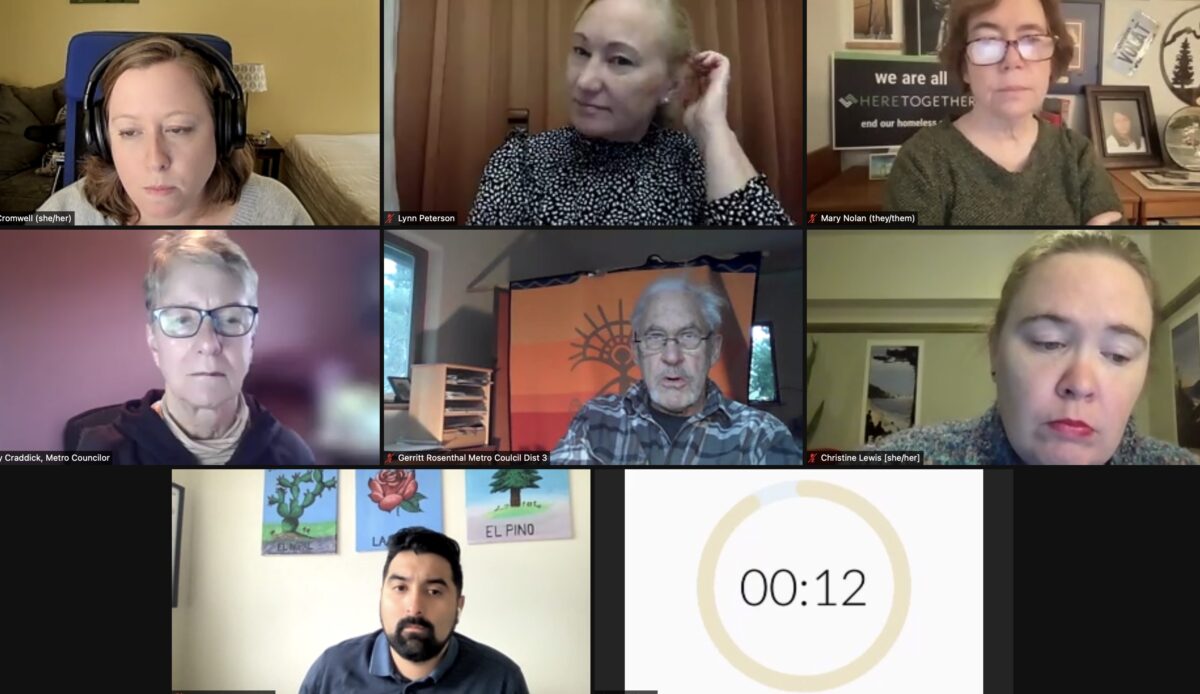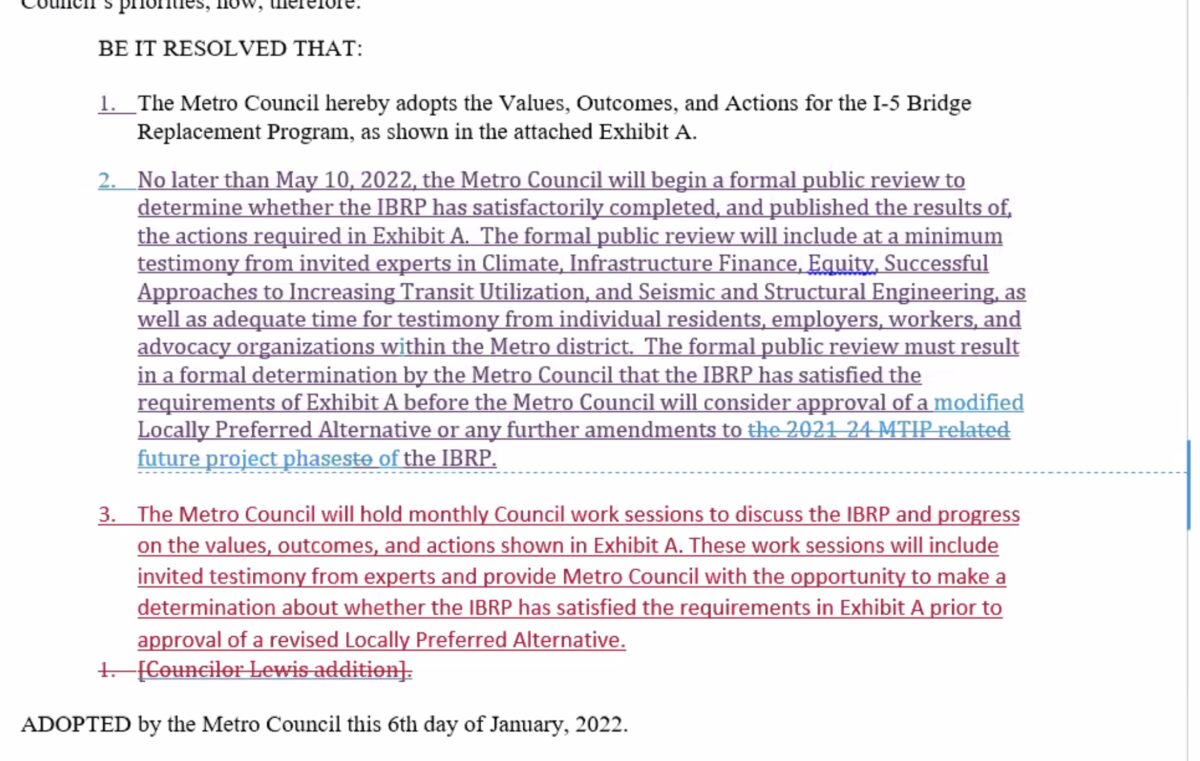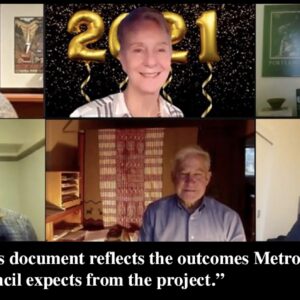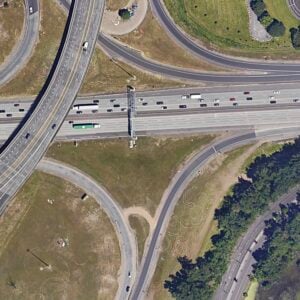
It was a mixed bag at Metro Council today as its six members tried to walk a fine line between allowing the I-5 Expansion/Interstate Bridge Replacement (IBR) project to move forward, and saving face with climate change activists — many of whom staged a protest rally against the project outside Metro headquarters Wednesday night.
On the agenda at Thursday’s council meeting were two key items: A Values, Outcomes, and Actions document meant to outline Metro’s expectations around the project, and a resolution to adopt an amendment to the Metropolitan Transportation Improvement Program (MTIP) to spend an additional $36 million to allow the IBR project team to continue planning the project.
As we’ve been reporting, there was a lot of tension around this vote because it’s a rare opportunity for Metro – one of eight official federal partners on the IBR project — to assert some influence over a freeway expansion project. Given the well-documented failure of the Columbia River Crossing project in 2013 (which this IBR project is based on) and heightened debate and urgency around the negative impacts of driving and freeways, Metro councilors were in the unenviable position of simultaneously staring down the freeway industrial complex and a burgeoning climate justice movement.
In the end, Metro Council blinked. They voted 5-1 in favor of funding the project, with Councilor Mary Nolan being the sole objector.
But it came with important progress for a coalition of advocacy groups who pushed Metro to ensure the project isn’t the climate change disaster some critics warn it could be.
“We are pleased to see the Metro Council… create clear goals and accountability mechanisms to meet the region’s goals for a sustainable, healthy, and effective transportation system,” read a statement after the meeting that was signed by No More Freeways, 1000 Friends of Oregon and The Street Trust. “We hope open communication and precise analysis of the options on the table will help ODOT and the IBR leadership right-size this project and create high quality multimodal transportation and positive community impacts.”
That coalition had a big impact on today’s proceedings. They convinced Metro to adopt three key additions to the Values, Outcomes, and Actions (VOA) document (below) that included commitments to lower vehicle miles traveled (VMT) reductions, conduct an “investment-grade” financial analysis to determine how wide the freeway needs to be, and to include a comprehensive health impact assessment for communities along the five-mile project corridor between Portland and Vancouver.
Advertisement
Below is the new text added to the VOA document. The first is Councilor Nolan’s amendment, followed by the three amendments from the advocacy coalition:
Councilor Nolan also added two pieces to the VOA that should increase transparency and accountability from the project team.
There was a significant amount of public comment at the meeting with all but two people speaking against the project. Portlander Paul Rippey used his three minutes to share an encore rendition of his hit single “Induced Demand” that I happened to capture a recording of (below):
It was clear throughout the meeting that a majority (if not all) of Metro Council isn’t comfortable with how wide I-5 proposals from the IBR team might be. During a thoughtful and detailed discussion about how to edit the text of the VOA document to make it as strong as possible, Metro Council President Lynn Peterson said, “The intent of this is to make sure that we’re right-sizing the bridge.”
But it was Councilor Nolan who was the strongest voice of skepticism against the IBR project staff. They repeatedly questioned the project team and was persistent in calling for stronger accountability language. Their amendment sought to give Metro the power to pull support for the project if the IBR team did not answer their questions or provide requested information. “If we’re going to support them [ODOT] in meeting their deadline for a locally preferred alternative [final design, which IBR says must come by this June, a deadline some say is nonexistent], we should be able to evaluate whether they’ve satisfied our request for due diligence.”
In the end, the VOA was adopted. Given that it’s just a document, it’s relatively strong and gives Metro much more power than they’ve had over previous megaprojects like the CRC. “This is something that wasn’t done last time,” Peterson said after the vote. “It sets a higher bar on how we proceed as a region.”
Then it was time to grapple with the $36 million question.
IBR Program Administrator Greg Johnson kicked off the discussion by telling council they don’t have as much power to “right-size” the bridge as they might have thought. He said the only tool the IBR team will use to determine the size of the bridge will be regional traffic modeling. That didn’t impress Councilor Shirley Craddick, who pointed out that, “Your data says we have a lot of cars and need a bigger bridge, but we can no longer accommodate that and have a healthy world, or maybe even a world at all… We’re basically saying we we can’t tolerate a bridge is 10 or 12 lanes wide.”
Johnson spoke strongly about the IBR project’s intentions to take climate change and other concerns seriously. But in the end, he said, “We must look at the data,” when it comes to determining the freeway design. He also responded to Metro’s concerns by saying they aren’t the only voice at the table. “I need everyone [on Metro Council] to understand that this is a bi-state program with eight partners that have individual needs… We’re trying to thread the needle to address all of those concerns,” he said.
Advertisement
President Peterson clearly wanted to maintain a positive relationship with the IBR project. She praised Johnson and thanked him for changing his tune over the past several months. “Greg, you came into this with a complete and utter trust deficit,” she said. “You have been willing to recognize that and have strived to rebuild trust… I just want to say thank you for that hard work and recognizing this is more than just a transportation project.”
When public comment started up again, Metro heard strong opposition and skepticism. State Rep Khanh Pham, a new member of the state’s powerful Joint Transportation Committee, said “I’m not sure why we need $36 million to answer these questions. Every dollar we spend on overbuilt freeways comes at a cost of not been able to fund other critical transportation needs.”
Pham also called out Johnson for his contention that the project faces a hard planning deadline. “When I talked with Metro staff and asked about these specific federal deadlines, I was told that there are no federal deadlines for this project; but it’s more that there’s a foot race around the region to compete with other projects.”
No More Freeways co-founder Aaron Brown said he thought Greg Johnson was “gaslighting” Metro Council and questioned whether ODOT’s trust deficit would be more accurately described as a “truth deficit”.
When it came time to vote, all the councilors expressed mixed feelings and discomfort, but every one of them except Mary Nolan, voted to support the $36 million amendment. Nolan said before their vote, “I’ve been disappointed by the indirectness and obfuscation I’ve heard from the two leaders of the project team… When given opportunities to embrace our requests, the project team director and deputy director have instead waffled. I vote no.”
When Councilor Gerritt Rosenthal answered his call for a vote with “I’m a provisional and conditional ‘yes'”, an exasperated Nolan could be seen shaking their head and we could hear them mumble under their breath, “It’s yes or no.”
Nolan (who won their seat by beating Chris Smith, a co-founder of No More Freeways) has emerged as Metro’s strongest freeway project skeptic. We haven’t heard the last of them on this project. And thanks in part to the strong Values statement Metro passed today and the community advocacy thus far, this won’t be the last chance to influence this project.
For more coverage of the meeting, check out my live Twitter thread
So the measure passes 5-1.
Nolan looks displeased.
When Councilor Rosenthal said he's a "provisional and conditional Yes" Nolan shook her head in disapproval and muttered "It's yes or no."
Thx for following along everyone.
— BikePortland (@BikePortland) January 7, 2022










Thanks for reading.
BikePortland has served this community with independent community journalism since 2005. We rely on subscriptions from readers like you to survive. Your financial support is vital in keeping this valuable resource alive and well.
Please subscribe today to strengthen and expand our work.
This whole process has been dominated by folks posturing against the project, but voting to move it forward. Sad.
Because they know it to be true that the vast majority of the public supports a new, larger bridge – and that the regional needs demand it.
No, Jeff – they *want* a larger bridge in the same way I want a larger slice of chocolate cake on my birthday. We want what is clearly not good for us, but what we truly *need* is to reduce VMT in Oregon and Washington. We are driving ourselves to a climate catastrophe.
Yeah, like I said – the public supports it, and it’s going to happen. It’s great that 31 of 33 people who signed up to talk on the zoom call disagree – and one even came armed with a guitar – but all know that’s not reflective of the populace.
Almost everyone who spoke at the meeting was against it. The councilors don’t care what the public wants. They are bowing to the corporate world with this vote.
I don’t think it’s that clear Chezz. Leaders of the advocacy coalition that includes No More Freeways are actually quite pleased at how the meeting went, given the totality of the situation. Metro was in a tough position and that VOA document is seen as a pretty important thing. It’s also clear that IBR is feeling the heat. The pressure campaigns are having an impact.
By the time construction starts, most cars will be electric. Enough with the doommongering.
That assertion has no basis in reality.
The most optimistic projections are that about a third of new car sales will be fully electric vehicles at the end of this decade. That means that the majority of new cars will still be fossil fuel powered, not even considering the existing car fleet, which will be even a higher percentage ICE. And the private motor vehicle fleet takes more than a decade to turn over. So it is likely that without major changes in policy, America will not have a majority electric car fleet for several decades to come.
If all cars are electric, then we don’t have to worry about pollution created by gridlock. No need to expand the freeway to “reduce emissions”.
It’s a bit more complex. If we had an up-down vote on the bridge as it is currently planned, I’m not sure if you would get a majority to approve.
Do the majority want a new bridge? Sure. Who doesn’t want new stuff for free?
Do the majority want a new bridge with MAX and tolls? This is very uncertain. Tolls are extremely unpopular, as is MAX in Clark County.
Thanks METRO Councillor Nolan for adding and fighting for the language “…to include a comprehensive health impact assessment for communities along the five-mile project corridor between Portland and Vancouver.”
It has always shocked me that until very recently BOTH of our sides of the river’s DOTs/ Health agencies were ‘allowed” to only ‘minimally’ monitor the transportation impact (air toxics) on the air quality of the urban neighborhoods adjoining major highway interchanges and bridges.
Please also add monitoring for “noise” pollution (as bigger fatter SUV tires and truck engines are making more noise as passenger cars get quieter) and heavy metals from brake pads and tire fluff off that then ends up in our Columbia River …and then our bio food web.
—
Why Air Toxics?
“Air toxics come from a variety of sources including cars and trucks,… and include diesel exhaust, benzene, polycyclic aromatic hydrocarbons (tar-like by-products from auto exhaust,…), and metals. Air toxics are known or suspected to cause serious health problems including cancer, nerve damage, and respiratory irritation.
Although the U.S. Environmental Protection Agency (EPA) sets ambient air quality standards for six criteria air pollutants under the National Ambient Air Quality Standards (NAAQS) program, air toxics are not regulated in the same way as criteria pollutants.”
“Multnomah County and City of Portland believe that all Oregonians have a right to breathe clean air and that this is a reasonable and achievable goal.”
– Local Collaborative and Regulatory Options to Ensure Healthy Air in the Portland Metro Area (2019)
—
SW Washington Clean Air
https://www.swcleanair.gov
Looking forward to less pollution producing traffic jams and improved bike paths.
Which project are you thinking about? The I-5 interstate expansion wont provide either.
Pollution will increase because more traffic will be moving over the bridge. 10 free-flowing lanes full of cars produces more pollution than 6 gridlocked lanes.
https://www.reuters.com/world/us/us-highway-expansions-increase-traffic-pollution-environmental-groups-say-2021-10-20/
Traffic jams only account for a small percentage of the overall pollution that is produced by vehicles on I-5. The modest reduction in emissions from idling vehicles will be overwhelmed but emissions from additional vehicle trips.
Oh wow, who could have guessed that Metro is completely full of it and cowed to it’s industrial owners.
Could we have an update on the NoMoreFreeways lawsuit, please.
PS: The metro council is and always had been pro-BAU so they are not the people getting gaslit.
It will be a case that likely gets decided on briefing to the judge given the nature of challenges. According to public info, the agency’s “record” (basically the administrative agency’s whole file and the entirety of the “evidence” a court considers in these cases) is due to be filed in court in May. There is likely some back and forth over what goes into the record, but once that is final, then the plaintiff’s have 60 days from them to file their paperwork asking the court to find in their favor and the defendants paperwork is due 30 days after the plaintiff’s paperwork. Give a month or two after the summary judgment briefing is all complete for the court to have arguments and then another month or so from a a final decision. If the decision is appealed, that could extend resolution of the case for 1-2 years. I think the project continues along unless the plaintiff’s get an injunction (which is presumably what they would ask for in their briefing). If they get their injunction, then I think the project is halted and the defendants can appeal which would tack on another year or two to get an appellate ruling. If the plaintiff’s don’t get their injunction and have to appeal, they would face a pretty high hurdle to get a stay pending the appeal to halt the project while the appeal is pending. https://www.pacermonitor.com/public/case/39547075/No_More_Freeways_et_al_v_United_States_Department_of_Transportation_et_al
For those people who upvoted this I want to clarify that my comment about the “lawsuit” was sarcasm. The arch-villain here is not “following orders” ODOT but the democratic legislature and democratic governor.
In a one-party state, the term ‘democrat’ loses most of its meaning.
Five out of six Metro councilors are saying that this 20 pound puppy is going to be well-behaved when it weighs 120 pounds because ….. “it told me that it has to ‘thread the needle to address all of [the] concerns.”
The political posturing, the saying one thing and doing another – it’s reaching cringe levels…
A more accurate title: “Staring down the overwhelming will of voters and climate change activists, Metro blinks”.
If Phoenix isn’t worried about climate change, then neither should Portland.
You have no idea what the will of voters is. The Columbia Bridge has never been on the ballot, and it’s not an issue that any elected officials have focused on during campaigns.
Opposing projects based on “induced demand” is absurd. It’s saying “don’t build this because people will use it.” But having people use it is the point. It means more people can engage in productive activity. If new road capacity fills up right away that’s not induced demand it’s unmet demand.
Advocates for limiting capacity on the Interstate Bridge are arguing that we should create congested conditions on purpose to discourage people from driving and to punish those who do. That approach is small minded and petty.
Bridges are a bottleneck in any system. The I-5 Bridge should be as big within reason to serve the long term needs of our nation long after we are all gone. It should include high capacity transit lanes that can be used by buses, light rail, or both. And improved ped /bike connections. It’s that simple.
More accurately, it’s saying “don’t build it because it will incentivize people to make different choices that will result in more driving.”
Induced demand can be a real and measurable phenomenon in some situations. The problem is that advocates tend to invoke it for everything, even where it makes no sense, diluting its power and making it a less effective argument. It is not true that every improvement to the road network induces demand; some changes just make things better.
It strikes me that building a bigger pipeline from Vancouver to Portland really will encourage more folks who work in Portland to move to Washington, not just make things better for existing drivers, but making the larger problem worse by adding more. That said, this may be less true if work-from-home sticks around, if we build light rail, or add tolling to the bridge.
You may disagree that a new bridge will increase driving; if so, make your case. But don’t just dismiss the concept of “induced demand” as absurd on its face.
Thanks for your thoughtful reply. My case is that a bigger bridge will allow more driving and that is a good thing for a 100 year bridge in a growing region. And I’m not dismissing the fact that the extra capacity will fill up, I’m saying that when the extra capacity fills up right away it’s not “induced demand” it’s “unmet demand.” But that is a short run issue more applicable to the Rose Quarter project.
In the long run it’s true that a bigger bridge would allow more people to live in Washington and commute. The alternative being proposed on this blog would create congestion on purpose to deny people that option. I think people are better off when they have more freedom to choose where to live, work, learn, and play. I’m for more capacity for every mode and let tolls pay for it.
I don’t think one can really say this. For example, if you make something else cheaper – let’s say we make candy bars half off, and suddenly sell twice as many – is that “unmet demand”, or did one induce that demand by making it cheaper? Basic econ tells me the latter is definitely in play. And more lanes for automobiles makes driving them cheaper.
But let’s grant your supposition for the moment: I think the two mentioned demands are different and being conflated. The “unmet demand” would be easy movement of people. The “induced demand” by adding more freeway lanes is travel specifically by automobile. We can – and should – meet the the former without the latter, both for sustainability, efficiency, and livability.
Bridgestone,
You’re not likely to make friends on this site. . They are more into imposing their fringe views on others than allowing people to make their own choices. They want to make it really hard to get to Portland and then complain about the housing price increases induced by long commute times. It’s more often than not an echo chamber of intolerant “Trumpers on the left”.
Won’t be a popular statement in this echo chamber but I’m super happy about the reduced gridlock that will happen and the increased efficiency for businesses. Not to mention the bike lane improvements.
In the end Oregon is going to have a 205 bridge part duex. The time to stop it was today and all proved they have a spaghetti noodle spine in the face of the construction lobby. Sad, Oregon. Sad. But the. Again, you couldn’t even get bike lanes in the hippiest of roads-Hawthorne.
Oregon has become a shadow if itself.
As a resident of District 6, I’m very disappointed that this important vote was held a week before the new District 6 councilor will be appointed. Really feeling the lack of representation here-things could have been different with a complete Council.
On the other hand, I’m impressed with Councilor Nolan’s no vote. I hadn’t seen them as strong champion against ridiculous freeway expansions, so very heartening that they have come out against the IBR.